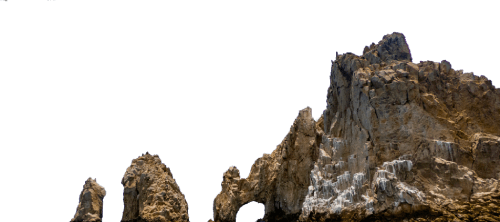At the southern tip of Mexico’s Baja California Peninsula, where the Pacific Ocean collides with the Sea of Cortez, lies one of Cabo San Lucas’ most awe-inspiring natural wonders: Land’s End. Known locally as El Finisterra, this dramatic landscape of sculpted granite cliffs and sea arches has captivated travelers, artists, and scientists for centuries. For those exploring Cabo with Mucho Cabo, understanding the story behind these formations enriches every sunset cruise, snorkeling adventure, or seaside stroll. Let’s dive into the geological drama, cultural lore, and vibrant ecosystems that make Land’s End a cornerstone of Cabo’s identity.
The story begins 115 million years ago during the Cretaceous period, when intrusive igneous processes formed the granite bedrock that underpins modern-day Cabo. Fast-forward to 30 million years ago, tectonic forces began pulling the Baja California Peninsula away from mainland Mexico. This slow-motion separation, driven by the subduction of the Farallon Plate beneath the North American Plate, created the peninsula’s jagged southern edge. By 5.3 million years ago, the Gulf of California (Sea of Cortez) had fully opened, isolating Baja and setting the stage for Land’s End’s iconic formations.
The star of Land’s End is El Arco (The Arch), a natural granite bridge carved over millennia by relentless wind and tidal erosion. Nearby formations like Neptune’s Finger (a towering spire) and Los Frailes (The Friars) share this origin story. These structures are part of a 30-million-year-old geological ensemble that continues to evolve. Recent studies reveal fractures at El Arco’s base, hinting at eventual collapse—though experts estimate this could take thousands of years, barring catastrophic hurricanes or human interference.
Long before Instagram influencers, Land’s End drew a different crowd: pirates. During the Manila-Acapulco Galleon Trade (1565–1815), English privateers like Sir Francis Drake and Thomas Cavendish lurked in its coves, ambushing Spanish treasure ships. The area’s labyrinthine caves and secluded beaches provided perfect cover for stolen gold, silver, and Asian silks. Today, guides still point out Pirate’s Cave, where legends claim loot was stashed.
El Arco isn’t just a geological marvel—it’s Cabo’s cultural heartbeat. This arch frames the meeting point of two seas, a spectacle immortalized in local art, jewelry, and tourism campaigns. Like the Eiffel Tower or Statue of Liberty, it’s shorthand for the destination itself. Visitors flock here for sunrise kayaking, snorkeling in Lovers’ Beach, or simply to witness pelicans dive-bombing the turquoise waters below.
The Cabo San Lucas Marine Park, a protected area encompassing Land’s End, is a biodiversity hotspot. Key sites like Pelican Rock and Neptune’s Finger burst with marine life:
- Sea lions bask on rocky outcrops.
- Schools of jacks and snappers swirl through underwater canyons.
- Sand falls—a surreal underwater avalanche of sand—plunge 100 feet into the abyss.
- Seasonal visitors include whale sharks (May–September) and humpback whales (December–April).
The terrestrial Área de Protección de Flora y Fauna Cabo San Lucas shelters over 800 species adapted to harsh desert conditions:
- Flora: Xerophilous scrub dominated by palo verde azul trees and cacti.
- Fauna: Coyotes, black-tailed jackrabbits, and the venomous Baja California rattlesnake.
- Birds: From the melodic northern mockingbird to the soaring magnificent frigatebird.
While El Arco’s eventual collapse is inevitable, conservation efforts aim to protect its legacy. The marine park enforces strict no-fishing zones, and local guides emphasize eco-friendly practices. For travelers, Mucho Cabo recommends:
- Sunset cruises with eco-certified operators.
- Snorkeling tours that respect marine life distances.
- Hiking nearby trails like Cerro del Vigía for panoramic views.
Land’s End is more than a photo op—it’s a living museum where geology, history, and ecology collide. From its pirate-infused past to its role as a modern-day sanctuary for sea lions and snorkelers, this landscape embodies Cabo’s rugged beauty and resilience. As Mucho Cabo continues to uncover the soul of Baja California, Land’s End remains a timeless reminder of nature’s power to shape both land and culture. Whether you’re tracing the footsteps of privateers or diving into its azure waters, every visit here is a journey through millions of years of Earth’s artistry.
